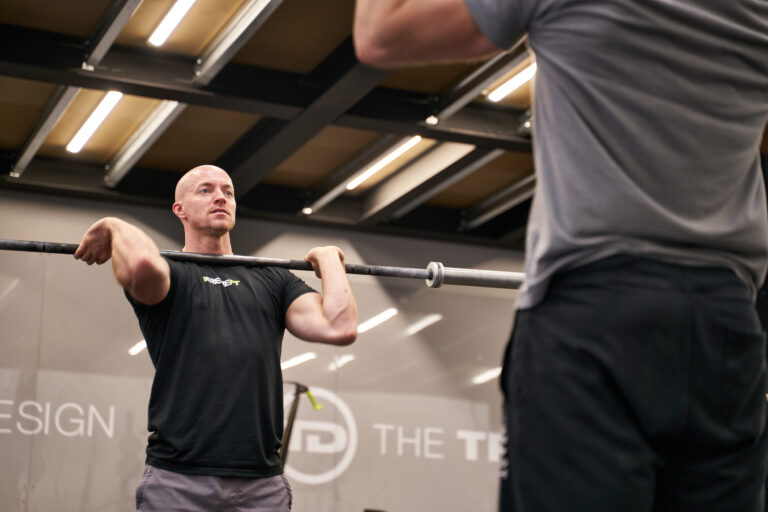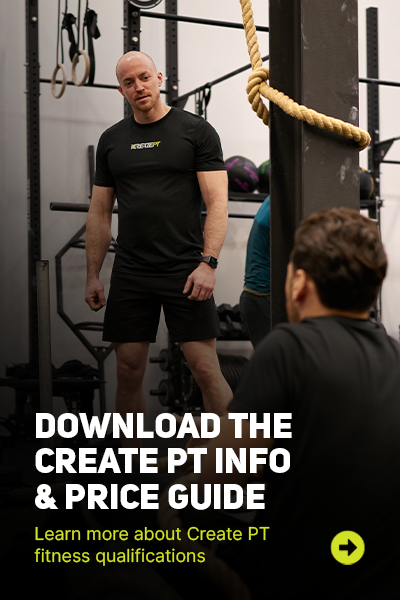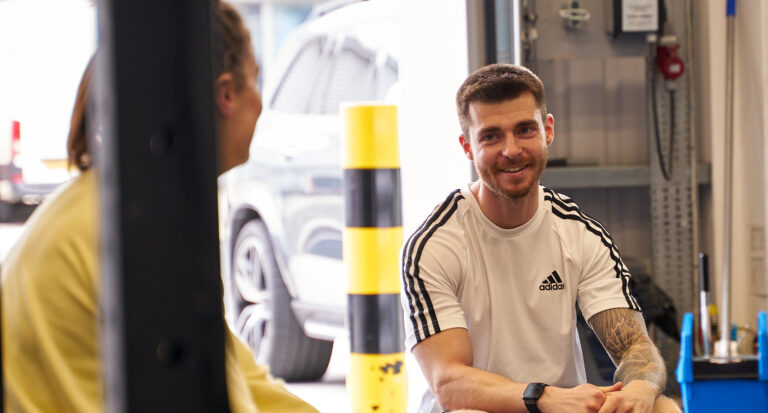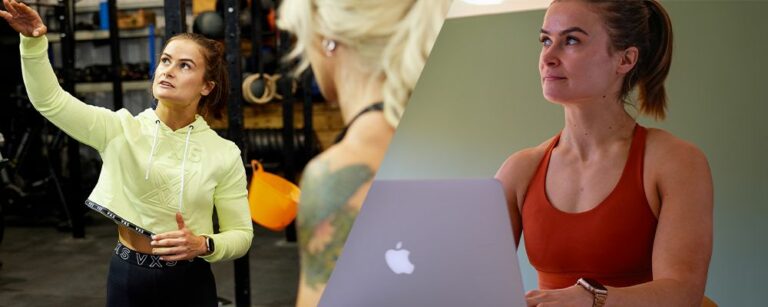The 1 rep max test is the most widely used test of absolute strength for a range of lifts. If you have clients working on improving their strength, or you’re interested in your own progress then you’ll want to know how to test your 1 rep max.
What is the 1 rep max test?
Your 1 rep max is the maximum weight you can lift for a single rep at a given exercise. You may also want to test 2 rep max, 5 rep max and 10 rep max, however the 1 rep max is the most commonly utilised.
The test is most commonly used for compound lifts; however, it can be applied to most lifts if you want to. Generally speaking, the following are the most useful lifts to measure:
Why do a 1 rep max test?
It is useful to know your 1 rep max for a number of reasons.
Firstly, for bragging rights obviously!
But more useful is to work out percentages to perform training lifts. When planning a programme for a client or yourself, you’ll need a measure to work from when prescribing what weight to use. If you know the clients’ 1 rep max then you can easily base their weights off that. For example, you prescribe 3 sets of 6 reps of back squat at 70% of 1rm, they know what weight to lift without you having to enter the weight each time.
If you need a way to log your workouts and prefer the old school pen and paper check out our logbooks here.
In addition to using it for programming, it is a great way to measure progress over time. It is incredibly taxing on the body to perform a true 1 rep max test, and ideally you would taper other training in the lead up to the test and programme de-load periods after, so I wouldn’t recommend testing more than a few times per year.
Alternatives to using 1 rep max with clients
If you don’t know your clients’ 1 rep max for a certain lift then there are 2 alternatives; the RPE scale or 1 rep max estimates.
The RPE scale stands for the rate of perceived exertion. It is a subjective measure of how heavy a lift feels with 1 being super easy and 10 being an absolute maximum effort. Only the client can tell you what their RPE was on a lift as there is no way of you knowing, so it falls short in that regard.
Also your RPE can vary from day to day due to a number of factors, so 80kg squats on one day may feel like an 8 RPE, then a few days later they may feel like a 6 RPE. This can in fact be a reason to use RPE over % of 1rm because it adjusts based on how you feel on the day. However with the subjective nature of it, most professionals tend to steer towards using a percentage of 1 rep max.
Estimates of 1 rep max are the other alternative. This is only really possible when you know the clients’ 2rm, 5rm or 10rm, as you can estimate their 1 rep max from those numbers.
It is obviously not as accurate as a true 1 rep max test, plus the calculation to estimate a 1 rep max from the high rep alternatives is a generic one and people’s ability to lift heavy for one or multiple reps can vary. For example, I can hit a fairly high percentage of my 1 rep max for multiple reps, but don’t have a very high 1 rep max. Some people may find they can lift a heavier weight for 1 but their 2, 3 or 5 rep max is a lower percentage.
Considerations when testing your 1 rep max
As I mentioned, it is incredibly taxing performing a 1 rep max test, so there are a number of things to take into account when planning it for yourself or a client.
Technical Ability
A 1 rep max test is not something I would carry out with a client who is new to exercise. When going for a maximum single rep effort you need to know that form and technique are going to be on point, so I would only consider this once your clients are technically proficient.
A good alternative to test strength for more beginner clients may be a higher rep test like 5 rep max, this way they are not maxing out a single lift under a load that may be too much for them.
Getting a true 1 rep max will always be a grind, however there is no point compromising technique to the point you could injure yourself in order to obtain a new 1rm. Instead, you should focus on achieving a technical 1 rep max, as a properly performed movement is far more useful for you than doing it wrong in order to lift more weight.
Timing
You’ll want to make sure the test is incorporated into a well-structured programme that tapers slightly in the lead up to it, and you should consider a de-load or rest period after the test.
In addition to fitting it into the rest of your programme, you’ll want to consider external factors that may affect your ability to perform a maximum effort. Things like menstrual cycle, stress, social events will affect when in a month you test, and the time of day you test could play a big part in performance too. I find I perform best at around 11am having had a good breakfast and another snack around half hour before training, some people prefer to train in the evening, so pick a time that works best for you or your clients.
Limitations
We would not recommend testing the 1 rep max of elderly clients, the risk is rarely worth the reward unless they’re an anomaly and they still train specifically for what you’re testing at their age.
Take into account injuries and medical conditions. You do not want to be testing a movement that may affect an injury. Remember to weigh up the risk/reward, is it really worth knowing your 1 rep max if you get injured, or worsen an injury in the process?
Is it really worth knowing your 1 rep max? If your sport is power lifting, then knowing your 1 rep max for squat, bench and deadlift is very useful. However, if you’re into endurance running then it’s not really necessary, you’d be better off testing run specific milestones such as 400m time and 5km time.
How to test your 1 rep max
Make sure you have a spotter on hand for when you start maxing out. This obviously varies from lift to lift, it may look a bit funny trying to spot someone deadlifting, however I wouldn’t attempt a bench press 1rm without a spotter.
Weigh in
I’d recommend weighing yourself beforehand, just so in future you can compare what your lifts were at certain bodyweights. It is also useful to compare your relative strength to others, if you weigh 80kg and squat 140kg you are relatively stronger than someone who weighs 100kg and squats 150kg.
Warm up
Your warmup should always be movement specific. Start with a heart rate raiser just to get the blood flowing a bit, this may be 5 minutes at an easy pace on a bike, rower or similar.
Then move into some dynamic movement specific warmups. By movement specific I mean there is little point doing lunges and air squats before testing your bench press. Pick some movements that work for you, but generally speaking the dynamic warm up movements should look similar to the movement you’re going to be performing. For example as a warmup for bench press I would do some banded rotator cuff movements, press-ups, banded pec flys, leaning lat stretch, cat/cows, banded tricep extensions. All should be aimed at mobilising the necessary joints and warming up the relevant muscle groups.
Then move into your warmup sets. I’d aim for 4-6 warmup sets, progressing the weight. Start with an empty bar and aim to make each rep perfect form, however light the load.
Base your warmup weights off a previous 1 rep max test or use an estimated 1 rep max if you don’t know it.
I would recommend the following sets to warmup:
Set 1: empty bar x 10
Set 2: 40% x 8
Set 3: 60% x 5
Set 4: 80% x 3
Set 5: 90% x 1
Rest periods
Rest periods should be between 1-5 minutes, the optimal amount of rest varies between individuals so go with what feels best for you. Scientifically speaking you want your ATP to be fully regenerated which takes 2.30 – 3 minutes after an intense set, however your ATP may not be fully depleted so just go with what feels best for you. You may want to increase your rest periods as the weight and level of exertion increases.
1 rep max attempts
After the 90% effort you should feel warm enough to start the single attempts. Start at a weight similar to your previous or estimated 1 rep max then go from there. It will likely take around 3 – 7 attempts to hit your 1 rep max. You want to get the balance right of how many attempts to make, too many and you may fatigue yourself, too few with too big jumps between attempts and you might use up your energy attempting a weight that is too heavy.
Remember your 1 rep max is the maximum weight you can hit for a single rep for full range of motion, no cheating on depth when it starts to get heavy.
Once you reach a weight where your spotter has to help, you lose form or you fail the rep it’s time to call it a day and take your previous successful lift as your current 1 rep max.
Using your results
As a personal trainer you’re likely to have a range of types of clients. Some that have no interest in lifting heavy at all, and some that only want to focus on that. The 1 rep max test will obviously only be useful for those interested in lifting, but for them it is probably the most useful metric to know.
Effective programme design is one of the key elements of being a good personal trainer, so knowing the 1 rep max of your strength focused clients will help you to programme far more effectively for them.
If you need help with coaching your clients or building up to a 1 rep max test for yourself then please get in touch using the schedule a call button in the bottom right & we can help you out.







